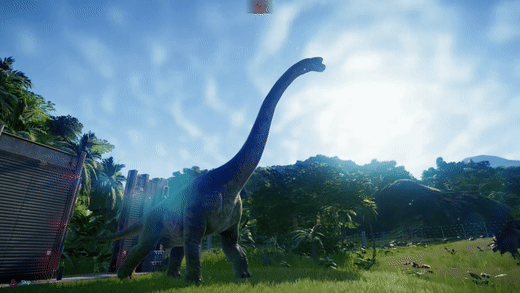Exciting New Releases: ZD Toys Collection
Exciting New Releases: ZD Toys Collection

Brachiosaurus: Full Jurassic Park Timeline, Death Scene, Trivia & Behind-the-Scenes
May 06, 2025 10 min read
Brachiosaurus belongs to the sauropod family—a group known for their immense size—and it's easily one of the most iconic dinosaurs ever discovered. Its name comes from its towering upper arm bone, the humerus, which is so long, it actually outmeasures the average adult human. For nearly a hundred years, Brachiosaurus held the title of the tallest dinosaur, standing over 20 metres high—like a four-storey building brought to life. That record has since been surpassed, but Brachiosaurus still looms large in our imagination.
It was first unearthed in Colorado back in 1900, and just a few years later, in 1903, it got its name from Elmer Riggs, a paleontologist from Chicago’s Field Museum. At one point, scientists believed Brachiosaurus roamed across North America, Africa (especially Tanzania), and even parts of Europe like Portugal, during the Jurassic Period. That made sense—after all, continents were arranged very differently back then. But later discoveries revealed that the African “Brachiosaurus” was actually a different dinosaur entirely: Giraffatitan, a close cousin but a distinct genus.
And here's something that might surprise you: recent computer modelling suggests Brachiosaurus might not have held its long neck upright like a giraffe, as once thought. Instead, it probably carried its neck forward at a graceful 45 to 60-degree angle—less sky-scraping sentinel, more sweeping arc across the treetops.
Cloned Titans: The New Brachiosaurus
These cloned Brachiosaurus were not quite like their ancient ancestors. For one, they chewed their food—something the original Brachiosaurus and most sauropods never did. This small change likely meant they didn’t need to swallow stones, or gastroliths, to help grind food in their stomachs.
They were also physically different. Their powerful hind legs gave them the strength to rear up into a tripod stance, letting them stretch even higher into the trees while feeding—a majestic, almost slow-motion rise to reach the canopy. And unlike the fossilized Brachiosaurus, which had a distinct claw on the first toe of each front foot and several on the back, these clones had more uniform, elephant-like feet—sturdy, rounded, and built for walking the jungles of Isla Nublar.
One of their most peculiar traits? Their nostrils sat high on their foreheads, not down near the snout where you'd expect them. It gave them a somewhat alien look—especially when paired with their haunting, whale-like hoots, which echoed across the island, slow and low like distant foghorns.
Visually, they came in two color variants: one a plain grayish-brown, and another with a soft, creamy underbelly and a striking turquoise sheen along the crest. Some scientists speculate these were signs of sexual dimorphism—the brighter, crested ones being males, while the more subdued individuals were likely females.
In essence, the cloned Brachiosaurus weren’t just dinosaurs—they were echoes of a prehistoric past, filtered through the lens of genetic resurrection and imagination.
The Rhythm of Giants: Brachiosaurus Behavior
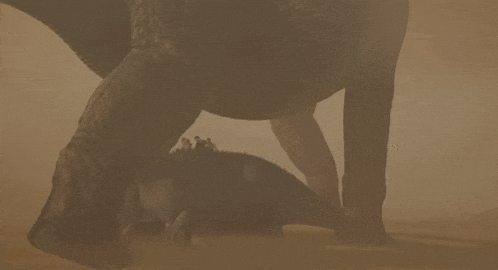
Brachiosaurus, though monumental in size, moved with surprising grace through its world—sometimes alone, more often in gentle herds. These creatures have been observed displaying both social and solitary foraging behavior. At times, an individual might wander away to browse in peace, only to later rejoin the group. In Jurassic Park, one such moment showed a female Brachiosaurus quietly feeding while the rest of her herd gathered at a nearby watering hole—not far off, just far enough for solitude. It was a quiet reminder that even the giants need space.
One of their most awe-inspiring behaviors is their ability to rear up on massive hind legs, lifting their bodies skyward to reach foliage far above the forest floor. When they rise like this, slow and steady, it’s as if time itself pauses—a monumental ballet move evolved for survival.
Young Brachiosaurus, still new to the world, depend deeply on their herd. If an infant becomes separated from its mother or the group, it will call out with high-pitched cries, urgent and persistent, until it finds them again. These calls echo through the trees, a voice both vulnerable and determined. What happens if those cries go unanswered for too long is less clear—but separation may force the young into short-term solitude, a dangerous state for such a tender age.
For all their size, Brachiosaurus are not fearless. The genetically engineered Scorpios rex, smaller but venomous, has instilled terror in even these colossal creatures. There are troubling accounts of adult Brachiosaurus succumbing to its toxic spikes—though it's still unknown how much venom was delivered or even if the attack was intentional. Regardless, fear of the creature lingers in the behavior of the herd.
In a quieter scene on the African plains, a small group of Brachiosaurus was seen peacefully grazing by the riverside as the Camp Family looked on. Towering yet tranquil, they paid little attention to the curious humans. When Kenji tried to startle them, they remained calm—confident in their size, unconcerned by human antics. But even giants can be spooked. One Brachiosaurus, lowering its head to drink, noticed sudden bubbles breaking the water’s surface. It jerked back in alarm—and that spark of fear rippled like thunder through the herd. Panic surged, and in seconds, the great creatures stampeded out of the river, chaos flaring with the crack of a flare gun cutting through the din.
Brachiosaurus are not just dinosaurs—they are living contradictions: serene yet mighty, social yet independent, vulnerable yet commanding. Each movement, each call, each glance tells a story of a creature both ancient and reimagined.
The History of Brachiosaurus: A Giant Reimagined
Creation and Early Life
InGen brought Brachiosaurus back from extinction—ten majestic individuals first cloned in the shadowed labs of Isla Sorna. Raised by human caretakers, these giants thrived until they reached maturity, when they were carefully relocated to Isla Nublar to become the living icons of Jurassic Park. There, in the lush Brachiosaurus Enclosure, they shared their habitat with Parasaurolophus, towering over the landscape like monuments from another world.
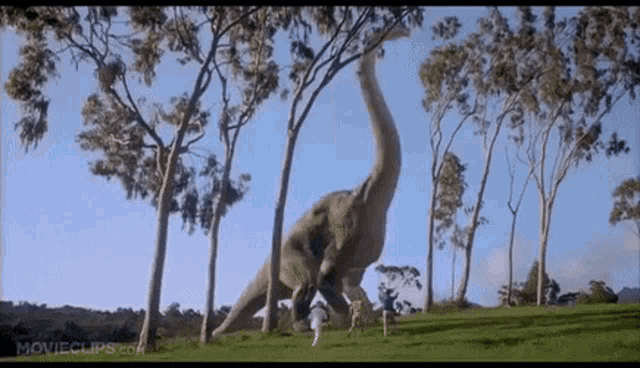
Jurassic Park: A Grand Entrance
When InGen’s endorsement team first arrived on Isla Nublar, it was the Brachiosaurus that greeted them—a breathtaking moment that silenced even the most skeptical. Dr. Alan Grant and Dr. Ellie Sattler, paleontologists hardened by theory and fossil, stood in stunned awe as the living myth browsed calmly before them. The Brachiosaurus was not a swamp-dweller, as they had once believed—but a land-roaming titan.
Later, as Jurassic Park's systems failed and chaos spread, these peaceful creatures roamed freely through the island’s wild interior. While fleeing a tyrannosaur, Dr. Grant and the children found refuge in a tree—only to wake in the morning to the sounds of a Brachiosaurus hooting nearby. The gentle interaction that followed—Tim petting its leathery skin, Grant feeding it leaves—was broken only when Lex was greeted by a sneeze to the face. A moment of connection, humor, and wonder. Afterward, their paths parted.
By late 1994, InGen confirmed at least five Brachiosaurus still survived on Isla Nublar. One died from malnutrition—a grim reminder of nature's harshness when caretakers vanish.
The Wilds of Isla Sorna
When Hurricane Clarissa struck Isla Sorna, InGen abandoned the island, releasing its dinosaurs into the wild. Brachiosaurus, now free, adapted by consuming plants rich in lysine to survive without human aid. They took up residence in the northeast—becoming the largest herbivores in the region. These wild variants looked different: beige with green stripes, and some with striking red crests—possibly males of this new lineage.
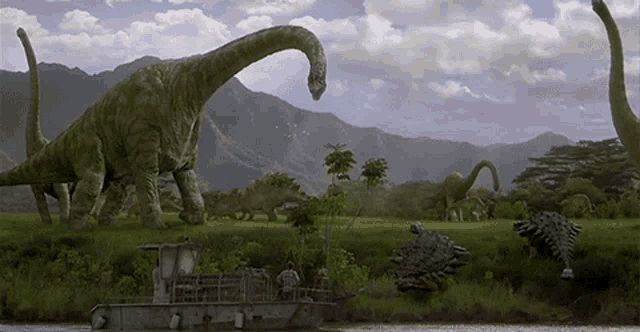
Jurassic Park III and Beyond
In 2001, during the search for Eric Kirby, a herd of Brachiosaurus was spotted once again, peacefully grazing near a riverbank. The sight was familiar, yet always majestic—a constant in a world that refused to stay still.
Jurassic World and the Rise of a New Era
A few Brachiosaurus were recaptured and returned to Isla Nublar for Jurassic World. One variant bore a shimmering blue stripe down its crest and neck, intended for the "Treetop Gazers" attraction. Though this feature never launched, Brachiosaurus became a beloved figure in the park, appearing on holograms and attractions.
In Camp Cretaceous, the species appeared frequently. Some lived near the summer camp, peacefully coexisting until disaster struck. One fell to the Indominus rex. Later, another was killed during a stampede triggered by the venomous Scorpios rex. After the park’s downfall, survivors roamed the island freely. One of these survivors, known as Firecracker, was cloned from Isla Sorna DNA by the shady Mantah Corp—only to be freed by the same young campers who had once fled from the chaos.

Fallen Kingdom: A Farewell to Home
By 2018, volcanic destruction loomed. As Mount Sibo erupted, one unforgettable Brachiosaurus—the very same individual first seen by Grant and Sattler 25 years earlier—was last seen standing at the dock, hooting in distress, slowly swallowed by ash and smoke as the Arcadia sailed away. It became a haunting symbol of paradise lost.
Some survivors made it onto the boat, including embryos and living specimens, smuggled to Lockwood Manor. While some were sold at auction, others escaped into the wild. One even wandered into a town where Darius and Kenji lived. By then, evidence suggested Brachiosaurus had endured cruelty in its lifetime—a dark chapter in its manufactured legacy.

Chaos Theory and Dominion
In Jurassic World: Chaos Theory, Brachiosaurus continued to feature prominently. From enclosure scenes at DPW Harbor to wild moments in Senegal—where their calm presence could shift to panic at the sight of a hippo—they proved as emotive as they were massive. One was even mistaken for a stray in the road, reminding us that these creatures, despite their scale, now share space with us.
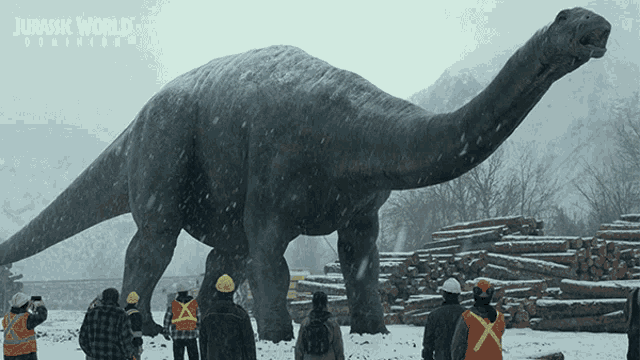
By 2022, sightings were confirmed in Cape Town, South Africa, Finland, and Brazil. Some Brachiosaurus found refuge in Biosyn Valley, coexisting with a variety of other species. When that valley was set ablaze by flaming locusts, they were evacuated once again. In the aftermath, a few were seen bathing and browsing by a lake—quiet survivors in a world forever changed.
Today, Brachiosaurus lives on—not just in our stories or science, but in the living world. Refugees of extinction, reminders of our ambition, and ambassadors of wonder, they walk on.
Brachiosaurus: Behind the Myth, Inside the Magic
A Dinosaur That Lived Twice as Long as We Dreamed
Of all the dinosaurs resurrected in Jurassic Park, Brachiosaurus holds a unique title—it’s the only one with a speculated maximum age. According to the original DVD encyclopedia for the first film, these gentle giants could have lived up to 200 years. In a world where life was built in labs and cut short by human folly, that kind of longevity feels almost mythical.
The First and the Last
The moment the Arcadia pulled away from Isla Nublar and a Brachiosaurus cried out on the dock, silhouetted against a sea of ash—it wasn’t just cinematic. It was symbolic. Jurassic Park began with the majesty of a Brachiosaurus (if you don’t count the Velociraptor's cage scene), and it ended with one. The first dinosaur we truly saw became the last to remain, marking both the rise and fall of a dream.
Behind the Scenes: Bringing the Giant to Life

A Creative Choice
Early in development, Phil Tippett argued for replacing the book’s Apatosaurus with either Brachiosaurus or the even larger Ultrasaurus. He felt they had a more compelling, almost otherworldly design. Brachiosaurus won the role, becoming a towering icon of awe. (Ultrasaurus would eventually make a cameo in Jurassic Park: The Ride.)
A Case of Mistaken Identity
David Koepp, the film’s screenwriter, originally confused Brachiosaurus with Brontosaurus—a slip that found its way into the final script. When Tim Murphy excitedly calls them “Brontosauruses,” it’s a little wink to the writer’s mix-up.
Animating a Legend
To give Brachiosaurus life, artist Mark “Crash” McCreery turned to the real giants of our time—African elephants. Studying their immense presence, he translated that same physicality into the dinosaur’s leathery skin and lumbering grace.
Stan Winston’s team crafted a full-scale Brachiosaurus head and neck puppet—an eight-foot-tall marvel with a 4-axis jaw that mimicked a cow chewing cud. Its famous sneeze? A blend of K-Y jelly, green and yellow food coloring, and a thickener—a disgusting mix that delivered a moment of pure movie magic.
CGI Firsts and Final Touches
Brachiosaurus was the first fully CGI dinosaur created in post-production. Spielberg, always attentive to detail, wanted the beast to be even bigger. When ILM doubled its size, they ran into a problem: it could no longer reach the tree branches it was supposed to eat! The animators adjusted the head and neck to fix the scale without breaking the illusion.
The model's movements borrowed from giraffes and elephants—grace from one, heft from the other. And the skin tone? Painted by TyRuben Ellingson to give it texture and realism.
Voicing a Giant
To create its haunting, melodic calls, sound designers blended noises from swans, geese, elephants, cows—and slowed-down donkeys. The result? A voice that was both majestic and otherworldly—just like the creature itself.
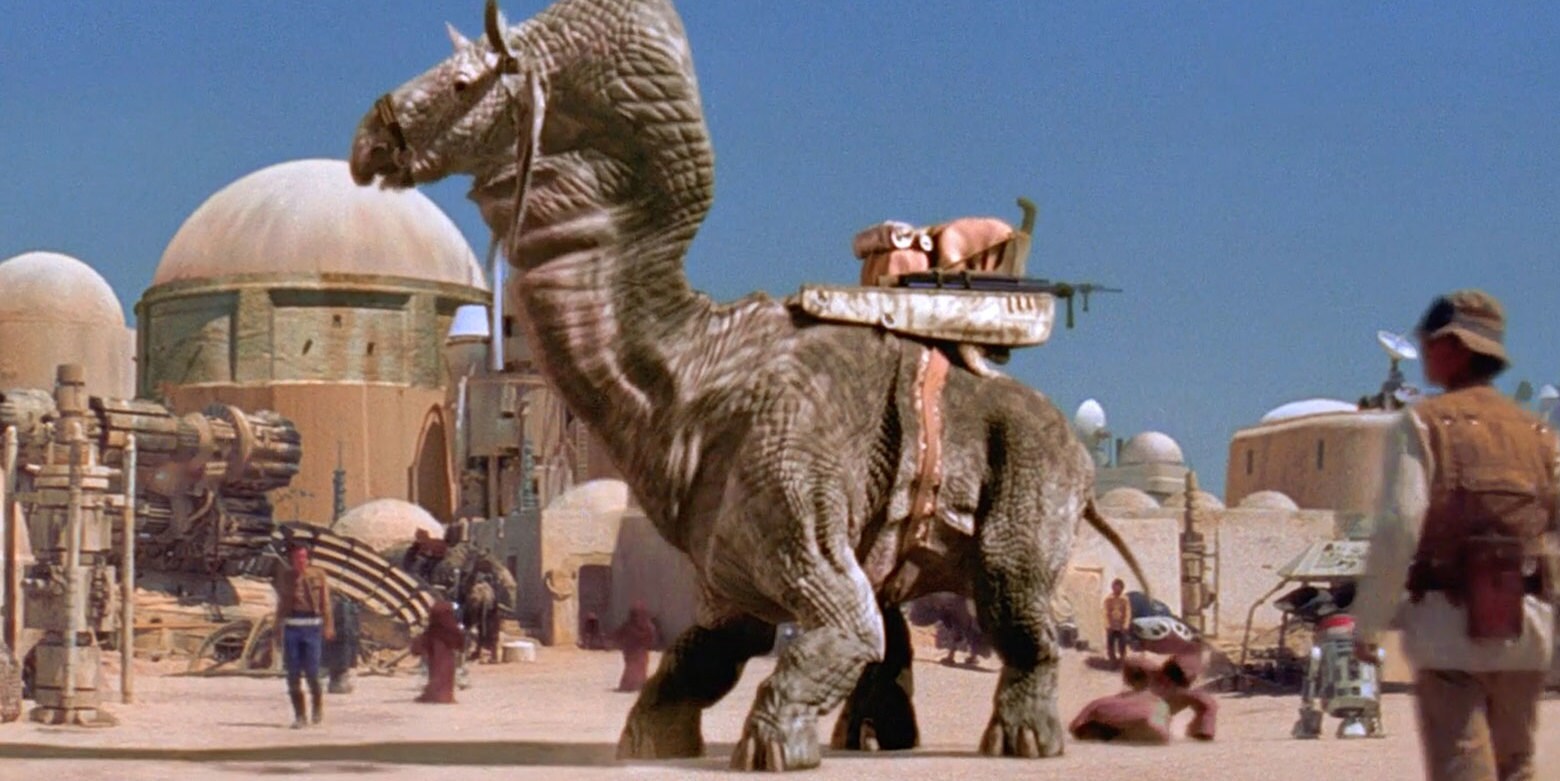
From Nublar to Tatooine
Believe it or not, the Ronto from Star Wars: A New Hope (1997 Special Edition) began life as a repurposed Brachiosaurus model. ILM even jokingly referred to it as “Bronto” before settling on the name “Ronto.” Later, that same model evolved into the Mamenchisaurus in The Lost World.
Cinematic Legacy
Empire Magazine ranked the first appearance of Brachiosaurus as the 27th most magical moment in all of cinema—a scene where storytelling, music, and visual wonder collided.
In early Jurassic World concept art, an attraction named “Brachiosaur Valley” was planned—an idea later reworked into the “Treetop Gazers” concept.
A Full Circle Ending
Director J.A. Bayona confirmed a heartbreaking detail: the Brachiosaurus seen dying on the dock in Fallen Kingdom is the very same one from the original 1993 film—the first dinosaur Alan Grant ever laid eyes on. The glow of the fire around it was a deliberate homage to E.T.'s glowing heart. A fitting tribute to a creature that captured ours.
Little Mistakes, Big Memories
Even the official Jurassic World website once mistakenly displayed a Brachiosaurus skull as belonging to Apatosaurus. Its icon in the Holoscape? Also Brachiosaurus. And its roar? Reused for Apatosaurus in the films. Like Tim Murphy, many fans still lovingly mistake Brachiosaurus for Brontosaurus—proof that some images are so powerful, they outlive the facts.
And So, the Legend Lives On...
From the misty treetops of Isla Nublar to the smoky ruins of a fallen dream, Brachiosaurus has walked with us through every chapter of Jurassic history. Not just a marvel of science fiction, but a symbol of wonder, nostalgia, and heartache. It's the first breathless moment we all remember—the towering head rising above the trees, the musical calls echoing into cinematic legend.
Whether you're a lifelong fan or a new explorer of the franchise, the Brachiosaurus reminds us why we fell in love with dinosaurs in the first place. Grace. Grandeur. And just a little bit of childlike magic.
Calling All Dino Fans!
Celebrate the legacy with us—head over to our website now for up to 40% OFF on all Jurassic World products, from collectible figures to apparel and beyond!
Limited time only. Relive the magic. Take home the roar. Click here to avail.
Subscribe
Sign up to get the latest on sales, new releases and more …


